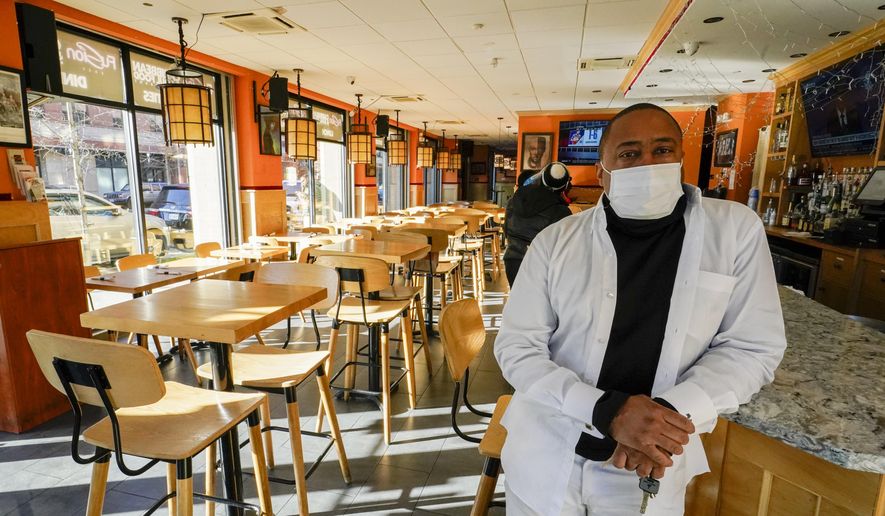ALBANY, N.Y. (AP) — Restaurants in some COVID-19 hot spots in New York can once again offer limited indoor dining in the wake of the latest lawsuit against Gov. Andrew Cuomo’s virus restrictions.
Up to four people per table can now dine indoors in seven so-called “orange zones” located in counties with some of the state’s highest rates of COVID-19 cases or hospitalizations: including Monroe County in the Finger Lakes. Restaurants outside New York City face a 50% capacity limit.
The decision comes a day after some Erie County restaurants won a preliminary injunction for themselves against the state’s enforcement of the indoor dining ban in yellow zones.
Cuomo’s counsel Kumiki Gibson said his office disagrees with the decision and is reviewing it. She pointed to federal data demonstrating indoor dining increases COVID-19 spread.
“While that process is ongoing, to ensure uniformity and fairness, all restaurants operating in orange zones can now operate under rules governing yellow zones,” she said.
State Supreme Court Justice Henry Nowak said he couldn’t “find evidence that the state had a rational basis to designate portions of Erie County as an orange zone” and that the restaurants would suffer “irreparable harm” without the injunction.
New York City’s restaurant industry is calling on Cuomo to also halt his indoor dining ban in the city. Manhattan has relatively low rates of cases and hospitalizations, though rates are higher in Staten Island.
“Continuation of the indoor dining ban in New York City is divorced from any of the data and criteria the state has articulated and must be ended now,” NYC Hospitality Alliance executive director Andrew Rigie and executive director and counsel Robert Bookman said in a joint statement.
It’s the latest lawsuit that has questioned Cuomo’s micro-cluster approach launched in October.
Cuomo proposed imposing COVID-19 restrictions based on addresses of people testing positive, rather than statewide like last spring. Courts long deferred to Cuomo’s emergency authority, but restaurants and houses of worships have seen some success arguing Cuomo has gone too far.
The Supreme Court barred Cuomo in November from enforcing 10- and 25-person attendance limits at churches and synagogues in Brooklyn and Queens hot spots. Cuomo called that decision “irrelevant” because he ended up easing restrictions in those neighborhoods.
But in late December, the U.S. Court of Appeals for the Second Circuit ruled Cuomo’s attendance policy “discriminates against religion on its face” and ordered the federal district court to issue a preliminary injunction prohibiting enforcement in red and orange zones statewide. Cuomo’s office didn’t respond immediately Thursday to a question about the status of those restrictions.
Cuomo’s Thursday announcement was welcome news for county officials and restaurant owners who question why Cuomo has kept only some orange zones even as cases rise elsewhere.
“We’re very happy,” David Cleary, an owner of Pudgie’s Pizza Pasta & Subs, which has two locations in Chemung County, said. “We’ve been very patient the last 80-plus days. It’s good for all restaurants and dine-ins, especially mom-and-pop locations.”
Critics question Cuomo’s data and say his approach leads to people driving outside zones to dine indoors. Cleary said other restaurants in Chemung’s orange zone started opening this week in defiance of Cuomo’s restrictions.
“We really wanted to, but we’re trying to do what’s right and abide by the law,” he said, adding: “Now that we’re all able to open it’s easier.”
New York now has no red zones and seven orange zones, even as nearly the entire state is seeing high enough positivity rates to qualify under Cuomo’s original red zone metrics. Cuomo hasn’t updated zones in weeks, and said in December he’ll shutter a part of the state only if regional hospitalization reaches critical levels.
Red zones shutter nonessential businesses and outdoor dining, while orange zones only allow outdoor dining or takeout and limit gyms and hair salons to 25% capacity. Cuomo originally shuttered schools in those zones, but later allowed them to reopen if they launch testing programs.
New York is far below the mid-April peak of COVID-19, but infections surged this fall and winter. The state now ranks 12th in the nation for its average of hospitalizations and new cases per-capita over the past seven days.
In central and northern New York, Herkimer and Lewis counties have averaged a higher rate of new COVID-19 cases per-capita than Arizona over the past seven days. Long Island’s Suffolk County has a higher rate than California.
And Cuomo’s approach has fueled disagreements between state and local officials, whose data can often differ, and confusion for residents.
Chemung County’s own dashboard cites 210 active cases, 70 deaths of county residents and 57 residents hospitalized. But the state’s data - which doesn’t include hospitalizations by county - lists 107 deaths in total and 720 new cases over the past 10 days.
County public health spokesman Vincent Azzarelli said he doesn’t know why the state’s fatality count is different. He said the county’s “active cases” are cases the department’s currently monitoring.




Please read our comment policy before commenting.